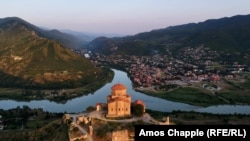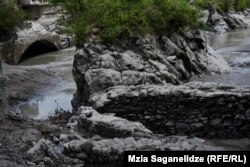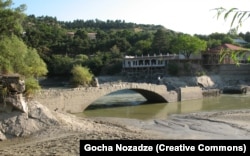The opening of floodgates at a Soviet-era hydroelectric dam north of Tbilisi has lowered the waters of the Mtkvari River, exposing a bridge across an ancient crossing point for archaeologists to study.
This is a rarely seen section of what is known as Pompey’s Bridge in the Mtkvari River, just north of Tbilisi, on May 28.
The remnants of the bridge usually are submerged and invisible beneath the surface of the river that runs through Georgia’s ancient capital of Mtskheta.
A year after this painting was made, a Swiss scientist and explorer described the span: “Its middle part was made of wood, the arch had long since collapsed and if indeed this bridge had been built by Pompey, it must be said that it had long been able to withstand the elements of nature. Who knows how many precious treasures are preserved for archaeologists in these ruins, which have not been explored by anyone yet..."
The bridge served for millennia as a crucial crossing point for international traders on their journeys across the Caucasus.
Pompey’s Bridge was named for the Roman ruler who invaded the Caucasus in the first century B.C. and fought a battle in Mtskheta. But a river crossing at the site is believed to have existed in some form long before Pompey’s time.
In 1926, Pompey’s Bridge was submerged beneath the Mtkvari River when this hydroelectric dam was built by the Soviets just 2 kilometers downstream.
Pompey’s Bridge is beneath the water in the upper left of this photo (near the modern bridge visible in distance) from 2017. The Zemo Avchala Dam is out of sight to the left.
On May 28, the private operators of the Zemo Avchala Dam opened its sluice gates, lowering the water level where Pompey’s Bridge was built.
Archaeologists were given about 48 hours to photograph and study the bridge. By May 31, with the dam’s sluice gates closed, it was submerged again.
Georgia’s Culture Minister Tea Tsulukiani told reporters the brief uncovering and study of the bridge marks the start of large-scale conservation work. But it is unclear how major renovations are to take place on the bridge if it remains underwater.








